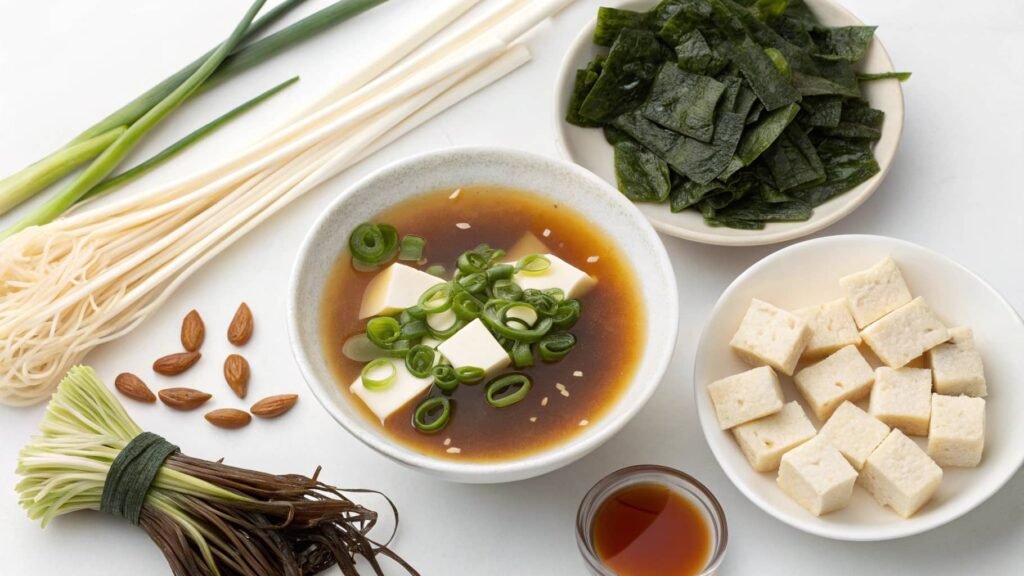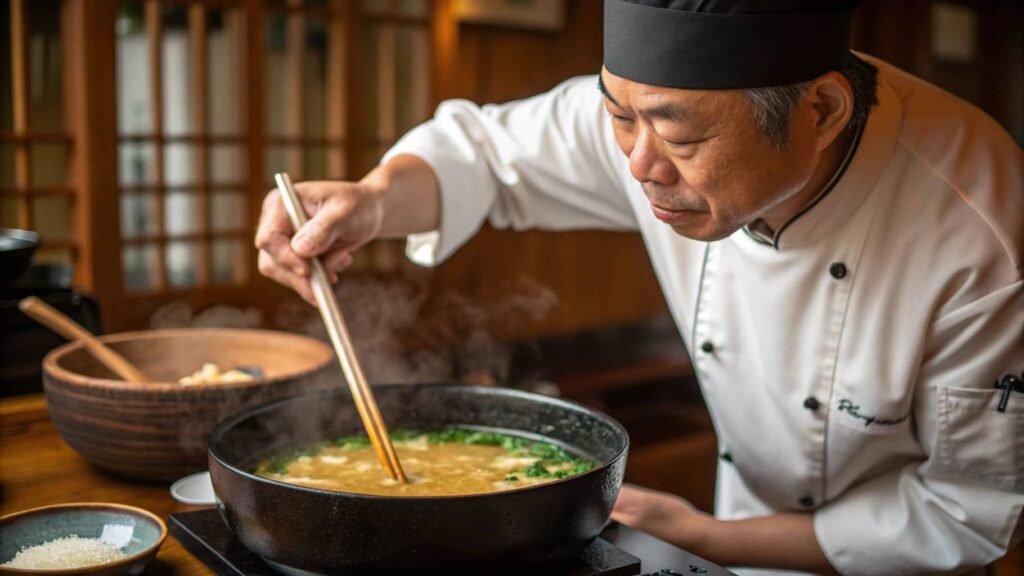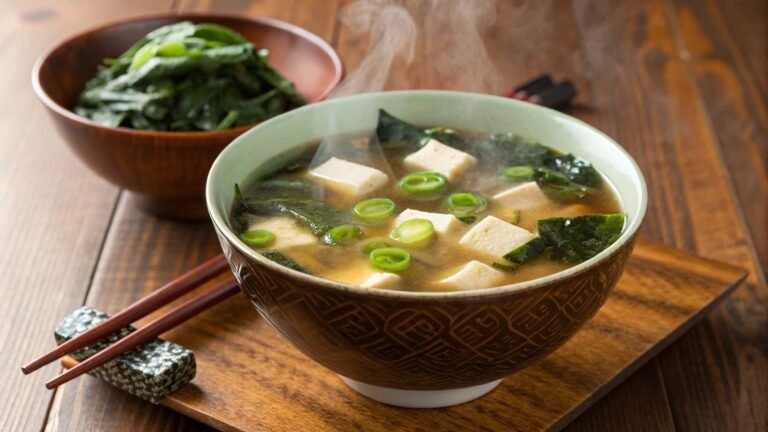There’s something truly magical about a warm bowl of miso soup. It’s not just food—it’s an experience, a comfort, a moment of pause in a chaotic world. Whether you’re sipping it at a sushi bar or making it from scratch in your kitchen, miso soup connects generations through tradition, flavor, and wellness.
Table of Contents
In this article, we’ll explore everything about miso soup—from its humble roots in Japanese kitchens to why it’s gaining love worldwide as a gut-friendly, immune-boosting, quick-to-make superfood. We’ll dive into its ingredients, health benefits, easy variations, and even solve the most common miso-making mistakes.
“Just like this comforting chicken soup that captures memories and healing in every spoonful, miso soup has a deep-rooted cultural warmth that nourishes both body and soul.”
What Is Miso Soup?
Miso soup is a traditional Japanese dish made primarily from fermented soybean paste (miso), a savory broth (dashi), and a mix of simple ingredients like tofu, wakame (seaweed), and scallions. It’s commonly served as a starter in Japanese meals, but its nutritional value and flavor have given it a spotlight all its own.
Brief History of Miso Soup
Dating back over 1,000 years, miso soup is rooted in Buddhist and samurai traditions in Japan. Monks relied on it as a protein source during vegetarian fasting, while warriors used it for strength and stamina. Miso paste itself has origins in China, but Japan embraced it, transformed it, and integrated it deeply into its culinary culture.
Miso Soup in Modern Cuisine
Fast forward to today, and miso soup isn’t just in Japanese restaurants—it’s in vegan cafés, health food stores, and even TikTok videos. From gut health to mindfulness rituals, people across the world are waking up to its benefits. It also fits beautifully into clean eating plans, low-calorie diets, and plant-based lifestyles.
Ingredients Used in Miso Soup

Essential Ingredients
- Miso paste (white, yellow, or red)
- Dashi (traditional Japanese broth made from bonito flakes or kombu seaweed)
- Wakame seaweed
- Silken tofu
- Green onions (scallions)
Each of these ingredients adds depth and texture. The miso paste provides umami and probiotics, dashi creates a smoky or earthy base, and wakame brings minerals and a soft bite. Tofu makes it satisfying, while green onions offer a crisp, fresh contrast.
👉 For measurements and a printable version, please refer to the recipe card at the end of the article.
Optional Add-Ins for Variety
- Mushrooms (shiitake or enoki)
- Daikon radish slices
- Grated ginger
- Carrots, spinach, or cabbage
- Rice noodles or udon (for a hearty variation)
These extra ingredients can turn a simple soup into a full meal or add regional flair depending on your taste preferences.
Nutrition Facts of Miso Soup
Miso soup is light yet packed with nutrients, thanks to its fermented and plant-based ingredients. Here’s a quick snapshot of its nutritional value:
| Nutrient | Per 1 Bowl (Approx. 1 Cup) |
|---|---|
| Calories | 75 |
| Protein | 5g |
| Carbohydrates | 6g |
| Fat | 3g |
| Sugar | 1g |
| Sodium | 700mg |
| Fiber | 1g |
Miso soup is a low-calorie option that’s easy to digest and surprisingly filling. Its high sodium content is worth noting—opt for low-sodium miso or reduce the quantity if you’re watching salt intake.
Step-by-Step Guide to Make Miso Soup

Making miso soup is surprisingly simple, even if you’re a beginner in the kitchen. Here’s a basic overview:
- Start by heating dashi in a pot over medium heat. Do not boil.
- Add rehydrated wakame seaweed and tofu cubes. Simmer gently for 2-3 minutes.
- Place a few tablespoons of miso paste in a ladle or bowl. Add hot broth and stir until smooth, then return it to the pot.
- Stir gently and turn off the heat. Add chopped green onions just before serving.
“Not sure which broth to use? This bone-based chicken soup recipe is a great comparison if you’re exploring other healing soups!”
Common Mistakes to Avoid
- Boiling the miso: This kills the probiotics. Always add it after removing from heat.
- Using too much miso paste: Start small and taste as you go.
- Adding raw tofu: It needs a brief simmer to soften and absorb flavor.
- Skimping on dashi: Don’t use plain water—your soup will lack depth.
If you’re looking for a refreshingly different soup option, this cool taco soup is a fun, fusion-inspired alternative!
Benefits of Eating Miso Soup

It’s not just tasty—miso soup is a wellness powerhouse. Thanks to its fermented ingredients and low-calorie density, it’s considered one of the healthiest everyday foods. Let’s explore why so many people, from dietitians to grandmas, swear by it.
Gut Health & Probiotics
Miso paste is a fermented food, meaning it’s full of live, active cultures—aka good bacteria for your gut. These probiotics help with digestion, reduce bloating, and improve nutrient absorption.
Think of your digestive system like a garden: miso soup helps you plant beneficial bacteria while crowding out the bad. It’s a simple way to support your microbiome without fancy supplements.
Immune System Support
Your gut is actually the command center for your immune system. When your microbiome is balanced, it can better fight off infections and inflammation. Enter miso soup—a natural immune booster.
Not to mention, it’s rich in antioxidants and nutrients like zinc and vitamin K, which are essential for immune response. It’s a great go-to if you’re feeling under the weather—or trying to avoid getting there.
“Want something equally nourishing but with a heartier broth? Try this bone-based chicken soup recipe for immune support and rich flavor.”
Weight Management & Fullness
Miso soup is low in calories, but don’t let that fool you. It’s surprisingly filling thanks to its umami-rich profile and tofu content. Sipping it before meals can help reduce overeating by giving you a light, satisfying start.
Also, the protein in tofu and fiber in seaweed helps keep hunger at bay. So if you’re trying to manage your weight without starving, miso soup is your new best friend.
Common Problems & Solutions
Even though miso soup is simple, it’s easy to mess up. Here are the most common missteps and how to fix them:
Too Salty or Bland?
If your soup tastes like seawater, you probably added too much miso paste or used a very salty dashi. Fix this by diluting the soup with water or a light unsalted broth. Next time, start with less miso and taste as you go.
On the flip side, if your soup tastes flat, try adding a bit more miso—but dissolve it in hot broth first so it blends smoothly. You can also boost umami with a splash of soy sauce or a sprinkle of nutritional yeast (especially in vegan versions).
Cloudy or Gritty Texture
This usually happens when miso paste isn’t fully dissolved or when it’s boiled. Remember—never boil miso! Instead, stir it in gently after removing the pot from heat.
Also, always use a small strainer or ladle to dissolve miso paste before adding it to the pot. It’s a small step that makes a huge difference in texture.
Different Variations of Miso Soup
Traditional miso soup is delicious on its own, but once you know the base method, it’s super fun to experiment. Here are a few ways to remix your soup without losing its soul.
Vegan & Vegetarian Miso Soup
If you don’t eat fish, skip the bonito flakes in dashi and use kombu (seaweed) and shiitake mushrooms instead. This creates a rich umami broth that’s 100% plant-based. Add in seasonal veggies like bok choy, carrots, or edamame for extra nutrition.
“For a hearty vegetarian meal, serve this soup alongside a quick and healthy taco soup recipe for an unexpected flavor journey.”
Spicy Korean-Inspired Miso Soup
Add gochujang (Korean chili paste), garlic, and kimchi to your miso soup for a spicy twist. It’s still packed with probiotics but has an extra zing and warmth—perfect for winter or when you want a kick.
Regional Japanese Variants
Did you know that miso soup recipes vary by region in Japan? Some areas use red miso for a stronger taste, while others add potatoes, pork, or even clams. The options are endless—and all authentic in their own right.
When and How to Serve Miso Soup
In Japan, miso soup is often served during breakfast. Yep, breakfast! It’s a great way to start the day with a warm, nourishing, and low-calorie option. You can also enjoy it as a side dish for lunch or dinner.
Pro tip: Serve it with a bowl of steamed rice and pickled veggies for a full Japanese-style meal. Or pair it with this soul-warming chicken soup for a comforting dinner lineup.
Miso soup also makes a great starter before heavier meals—it sets the tone, warms the stomach, and curbs hunger in a healthy way.
FAQs
Can miso soup be eaten every day?
Yes! Miso soup is a healthy, low-calorie option rich in probiotics. Just monitor your sodium intake if you’re eating it daily.
Is miso soup good for weight loss?
Definitely. It’s low in calories, filling, and supports digestion, making it an ideal addition to a weight-loss-friendly diet.
What kind of miso is best for soup?
White miso (shiro miso) is the most versatile and mild, perfect for beginners. Red miso offers a deeper, stronger flavor.
Why does miso soup sometimes taste too salty?
This could be from using too much miso paste or salty dashi. Try diluting it with water or switching to low-sodium broth.
Can I make miso soup without dashi?
Yes. You can substitute with vegetable broth or mushroom stock for a vegan-friendly and flavorful alternative.
Conclusion
Miso soup is more than just a starter—it’s a nutrient-dense, probiotic-packed powerhouse that’s simple, delicious, and adaptable. Whether you’re slurping it at a sushi spot or making your own at home, it’s a versatile dish that fits into nearly any lifestyle or diet.
From its ancient roots in Japan to its trendy presence in modern health food kitchens, miso soup remains timeless. It’s soothing when you’re sick, satisfying when you’re hungry, and quick when you’re busy.
With this guide, you’re now equipped to make authentic, healing miso soup right in your kitchen. Don’t forget to experiment with your own twists and pair it with other nourishing dishes to make your meals even more memorable.
Print
Classic Japanese Miso Soup
This easy miso soup recipe brings comforting umami flavors with tofu, wakame, and scallions in a dashi-based broth.
- Total Time: 15 mins
- Yield: 2 servings
Ingredients
-
Miso paste
-
Dashi
-
Wakame seaweed
-
Silken tofu
-
Green onions
-
Optional: mushrooms, carrots, miso varieties
Instructions
-
Heat dashi in a saucepan without boiling.
-
Add wakame and cubed tofu. Simmer gently.
-
Dissolve miso paste in a ladle with some broth, then stir it back in.
-
Add chopped green onions, stir, and serve hot.
Notes
Do not boil the miso once added to preserve the probiotics and flavor.
- Prep Time: 5 mins
- Cook Time: 10 mins
- Category: Soup
- Method: Simmering
- Cuisine: Japanese
- Diet: Vegetarian
Nutrition
- Serving Size: 1 bowl
- Calories: 75
- Sugar: 1g
- Sodium: 700mg
- Fat: 3g
- Saturated Fat: 0.5g
- Unsaturated Fat: 2.5g
- Trans Fat: 0g
- Carbohydrates: 6g
- Fiber: 1g
- Protein: 5g
- Cholesterol: 0mg


